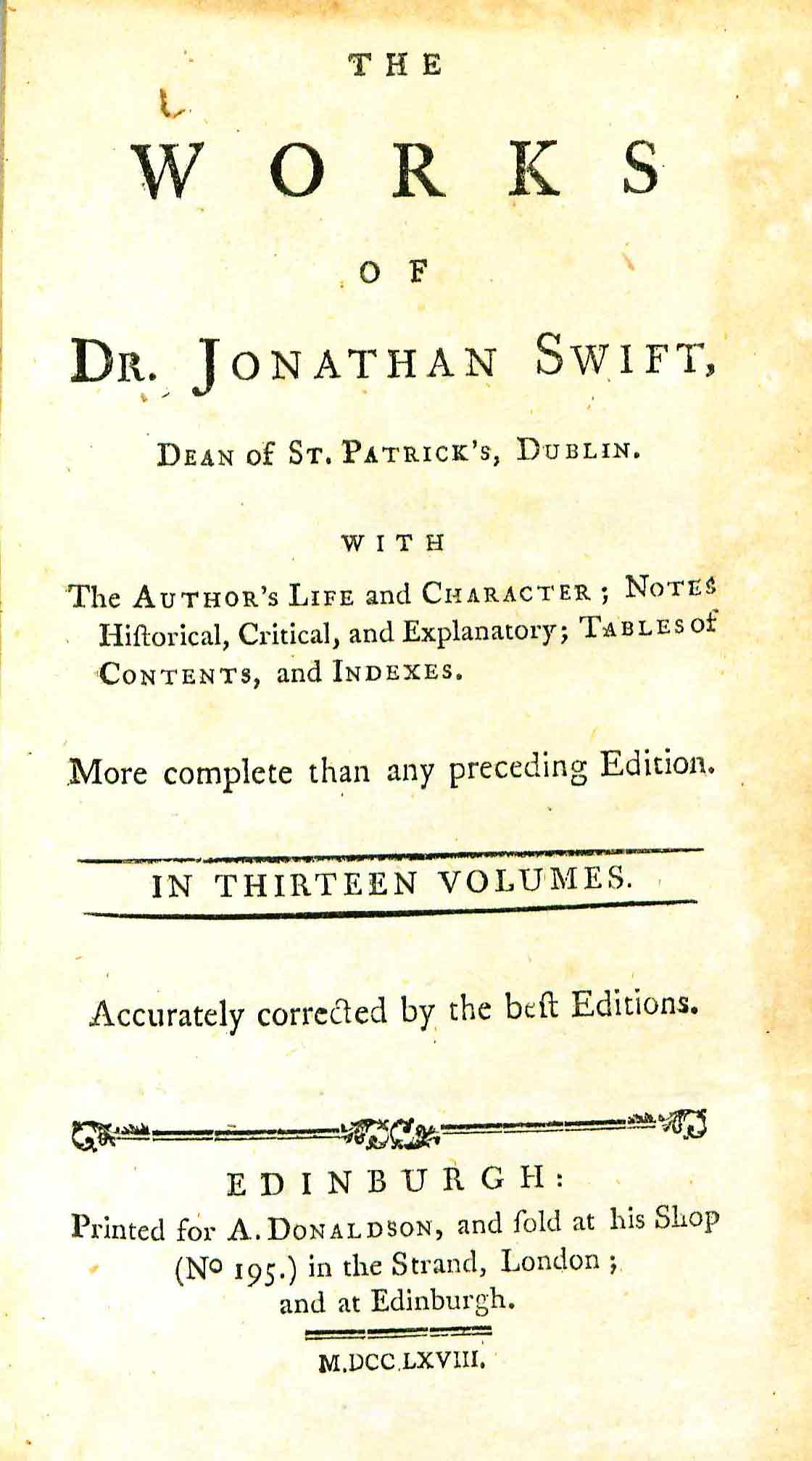Difference between revisions of "Works of Dr. Jonathan Swift"
| Line 1: | Line 1: | ||
| − | {{DISPLAYTITLE:''The Works | + | {{DISPLAYTITLE:''The Works of Dr. Jonathan Swift''}} |
| + | <big>''The Works of Dr. Jonathan Swift, Dean of St. Patrick's, Dublin with the Author's Life and Character, Notes Historical, Critical and Explanatory, Tables of Contents and Indexes More Complete than any Preceding Editions: in Thirteen Volumes Accurately Corrected by the Best Editions''</big> | ||
===by Jonathan Swift=== | ===by Jonathan Swift=== | ||
__NOTOC__ | __NOTOC__ | ||
| Line 5: | Line 6: | ||
|imagename=SwiftWorks1768v1.jpg | |imagename=SwiftWorks1768v1.jpg | ||
|link=https://catalog.swem.wm.edu/Record/3452353 | |link=https://catalog.swem.wm.edu/Record/3452353 | ||
| − | |shorttitle= | + | |shorttitle=The Works of Dr. Jonathan Swift |
|vol=volume one | |vol=volume one | ||
|author=Jonathan Swift | |author=Jonathan Swift | ||
| Line 24: | Line 25: | ||
''The Works of Dr. Jonathan Swift'' compiles many of his works with the circumstances of his life and public image. Swift’s nuanced writing remains controversial today; his satire is uncomfortably self-aware in its criticism of human nature and social issues. | ''The Works of Dr. Jonathan Swift'' compiles many of his works with the circumstances of his life and public image. Swift’s nuanced writing remains controversial today; his satire is uncomfortably self-aware in its criticism of human nature and social issues. | ||
| − | |||
| − | |||
==Evidence for Inclusion in Wythe's Library== | ==Evidence for Inclusion in Wythe's Library== | ||
Revision as of 14:35, 28 January 2014
The Works of Dr. Jonathan Swift, Dean of St. Patrick's, Dublin with the Author's Life and Character, Notes Historical, Critical and Explanatory, Tables of Contents and Indexes More Complete than any Preceding Editions: in Thirteen Volumes Accurately Corrected by the Best Editions
by Jonathan Swift
| The Works of Dr. Jonathan Swift | |
|
Title page from The Works of Dr. Jonathan Swift, volume one, George Wythe Collection, Wolf Law Library, College of William & Mary. | |
| Author | Jonathan Swift |
| Published | Edinburgh: Printed for A. Donaldson and sold at his shop in London, and at Edinburgh |
| Date | 1768 |
| Language | English |
| Volumes | 13 volume set |
| Desc. | 18 cm. (12mo). Vol. 1 has added t.p. Vol. 13 includes index. |
Jonathan Swift (1667-1745) rose out of a disadvantaged upbringing in Ireland to a position of intellectual superiority.[1] He began writing in 1689, publishing his first book, A Tale of the Tub, in 1696, under the patronage of Sir William Temple.[2] He continued to write poetry and critical essays, and rose in both Irish and English intellectual circles until he was exiled from England and permanently returned to Ireland in 1714.[3]
After his return to Ireland, Swift rebelled against colonialism and began to write about politics and social injustice. During this time, he wrote A Modest Proposal, which criticizes abusive church practices, and numerous essays that revealed the abysmal conditions of the overpopulating poor. In one of his most famously provoking essays, Swift put forth a satirical pamphlet that suggested the wealthy should eat the children of the poor to solve social problems. He became a champion for the people of Ireland because of his expression of hatred towards the injustice and oppression he observed there.[4]
Swift is best known for his satire Gulliver’s Travels (1726), in which he displays his liberal attitude, idealism, and belief in social reform governed by reason and justice. Instead of commenting on individuals or contemporary social movements, Swift imaginatively discusses the flaws of human nature and general concepts of morality though this satire.[5]
The Works of Dr. Jonathan Swift compiles many of his works with the circumstances of his life and public image. Swift’s nuanced writing remains controversial today; his satire is uncomfortably self-aware in its criticism of human nature and social issues.
Evidence for Inclusion in Wythe's Library
Description of the Wolf Law Library's copy
Bound in contemporary full brown calf, spines decoratively tooled in gilt in compartments in a floral design, dark brown gilt morocco lettering labels and five raised bands (all ruled in gilt). Purchased from Dragon Books.
View this book in William & Mary's online catalog.
References
- ↑ Harry T. Baker, “Jonathan Swift,” The Sewanee Review, 34:1 (1926), pp. 1-11.
- ↑ L.M. Harris, “Jonathan Swift,” The Sewanee Review, 3:2 (1895), pp. 231-248.
- ↑ Clive Probyn, “Swift, Jonathan (1667–1745)”, Oxford Dictionary of National Biography (Oxford University Press, 2004), accessed October 10, 2013. All biographical information is from this source unless otherwise noted.
- ↑ Harris, p. 247.
- ↑ Baker, pp. 3-4.
